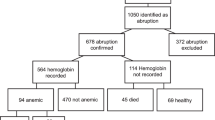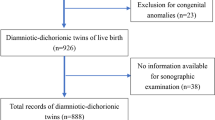Abstract
Objective:
To determine if the second trimester placental location is associated with perinatal outcomes.
Materials and methods:
Observational study of placental location and the subsequent risk of an adverse pregnancy outcome. Placental location was divided into three categories, low, high lateral and high fundal.
Results:
There were 3336 pregnancies analyzed in this study. Low implantation sites had a greater risk of preterm labor (odds ratio (OR) 1.70, 95% confidence interval (CI) 1.38 to 2.90, P<0.001), preterm delivery (OR 1.86, 95% CI 1.36 to 2.54, P<0.001), fewer fetuses with macrosomia (OR 0.56, 95% CI 0.38 to 0.83, P=0.010) and reduced risk of postpartum hemorrhage (OR 0.56, 95% CI 0.46 to 0.95, P=0.026). High lateral implantations had a greater risk of low 1-min (OR 1.80, 95% CI 1.11 to 2.93, P=0.017) and 5-min (OR 3.49, 95% CI 1.46 to 8.36, P=0.005) Apgar scores.
Conclusions:
Low placental implantation was associated with an increased risk of preterm labor, preterm delivery and a reduced risk of postpartum hemorrhage, and of a macrosomic fetus. High lateral implantation was associated with low Apgar scores.
This is a preview of subscription content, access via your institution
Access options
Subscribe to this journal
Receive 12 print issues and online access
$259.00 per year
only $21.58 per issue
Buy this article
- Purchase on Springer Link
- Instant access to full article PDF
Prices may be subject to local taxes which are calculated during checkout

Similar content being viewed by others
References
Bhide A, Prefumo F, Moore J, Hollis B, Thilanganathan B . Placental edge to internal os distance in the late third trimester and mode of delivery in placenta previa. BJOG 2003; 110: 860–864.
Leiberman JR, Fraser D, Kasis A, Mazor M . Reduced frequency of hypertensive disorders in placenta previa. Obstet Gynecol 1991; 77: 836–839.
Bobrowski RA, Jones TB . A thrombogenic uterine pack for postpartum hemorrhage. Obstet Gynecol 1995; 85: 836–837.
Gonser M, Tillack N, Pfeiffer KH, Mielke G . Placental location and incidence of preeclampsia. Ultraschall Med 1996; 17: 236–238.
Vaillant P, Best MC, Cynober E, Devulder G . Pathological uterine readings when the placenta is laterally situated. J Gynecol Obstet Biol Reprod 1993; 22: 301–307.
Fianu S, Vaclavinkova V . The site of placental implantation as a factor in the aetiology of breech presentation. Acta Obstetr Gynecol Scand 1978; 57: 371–372.
Newton ER, Barass V, Cetrulo CL . The epidemiology and clinical history of asymptomatic midtrimester placenta previa. Am J Obstet Gynecol 1984; 148: 743–748.
Newnham JP, Evans SF, Michael CA, Stanley FJ, Landau LI . Effects of frequent ultrasound during pregnancy: a randomised controlled trial. Lancet 1993; 342 (8876): 887–891.
Magann EF, Evans SE, Newnham JP . Placental implantation at 18 weeks and migration throughout pregnancy. South Med J 1998; 91: 1025–1027.
Author information
Authors and Affiliations
Corresponding author
Rights and permissions
About this article
Cite this article
Magann, E., Doherty, D., Turner, K. et al. Second trimester placental location as a predictor of an adverse pregnancy outcome. J Perinatol 27, 9–14 (2007). https://doi.org/10.1038/sj.jp.7211621
Received:
Revised:
Accepted:
Published:
Issue Date:
DOI: https://doi.org/10.1038/sj.jp.7211621
Keywords
This article is cited by
-
Cumulative Prenatal Risk Factors and Developmental Coordination Disorder in Young Children
Maternal and Child Health Journal (2023)
-
Relationship between placenta location and resolution of second trimester placenta previa
Journal of Huazhong University of Science and Technology [Medical Sciences] (2017)



